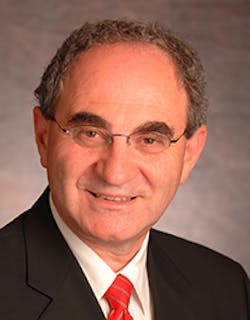
The Institute of Physics (IOP) in London announced this year’s award winners, including three related to photonics. The Isaac Newton Medal goes to Eli Yablonovitch from the University of California, Berkeley, for contributions to photonic nanostructures. Rahul Raveendran-Nair, University of Manchester, was awarded the Moseley Medal for his contributions to understanding the electrical, optical, and structural properties of graphene and its sister compounds. And Nikolay Zheludev, University of Southampton, won the Young Medal for global leadership and pioneering, seminal work in optical metamaterials and nanophotonics.
In the words of the IOP:
Professor Eli Yablonovitch is a scientist with a profound understanding of fundamental physical and engineering principles in photonics and a keen interest in translating these concepts into practical applications that address real societal issues. A key theme throughout his work has been the problem of solar cell efficiency, which he first started working on in the early 1980s, then with the Exxon Research Centre. He introduced the 4n2 factor that describes the light-trapping phenomenon applied in all high-performance solar cells, and that is still widely referenced in research papers on light trapping today. His 4n2 factor is now also referred to as the “Yablonovitch Limit”.
He developed the photonic bandgap concept, motivated by the desire to suppress spontaneous emission in photonic devices. The idea of photonic bandgaps brought together concepts from solid state physics and photonics and it eventually spawned the entirely new research field now known as photonic crystals. Photonic crystals have caused a true paradigm-shift in photonics, based on their ability to control the flow of light to an extent that was hitherto unthinkable. As a result, photonic crystals are now being used in research areas as diverse as quantum computation, nanoscale imaging and sensing, photovoltaics, optical interconnects, and high performance LEDs.
Dr Rahul Raveendran-Nair has made several outstanding contributions to graphene science and technology. These are remarkable achievements for an early-career researcher. Following research at the Indian Institute of Science in Bangalore on Raman spectroscopy and field emission of carbon nanotube/polymer composites, Raveendran-Nair commenced his research at Manchester as a PhD student, followed by appointments there as a research associate, Leverhulme Fellow and Royal Society University Research Fellow.
His research has led to several major contributions to the understanding of graphene science and its application in technology. A particularly important discovery was that graphene-based membranes, which are impermeable to helium atoms, are highly permeable to water. This discovery has led to great specialist and popular interest. A second remarkable discovery is that graphene, a single hexagonal array of carbon atoms, absorbs precisely πα = 2.3% of the light incident upon it over a wide range of optical wavelengths. Here α is the fine structure constant of electromagnetism.
Professor Nikolay Zheludev is one of the founding members, global leaders, and pioneers of nanophotonics and metamaterials--fields that have revolutionized optics in the last few years. His seminal contributions to the science of nanophotonics and metamaterials are fundamental to the discipline and in the fullness of time will find their way into textbooks. He is driven by the desire to develop new applications of photonic technologies, and his work is characterised by an exceptionally high degree of novelty and breadth.
Zheludev described two- and three-dimensional chiral metamaterials, discovered “extrinsic” optical activity, the asymmetric transmission effect and chiral negative refraction in metamaterials. He provided the first demonstrations of a metamaterial analogue of electromagnetically-induced transparency, “invisible metal” metamaterial, “magnetic mirror” at optical frequency, toroidal electromagnetic dipolar response and non-radiating charge–current configurations.
Zheludev pioneered work on a new generation of nonlinear, gain, switchable and memory metamaterials using carbon nanotubes, graphene and superconductors, and created microelectromechanical systems and nanoelectromechanical systems metamaterials reconfigurable with electrical signals and light. He developed coherent control of metamaterials’ electromagnetic response.
Zheludev invented the concept of nanophotonics of structural transformations, with a single-nanoparticle, and developed phase-change metamaterials. He introduced the “active plasmonics” paradigm and provided the first realisation of a femtosecond plasmonic gate. He provided the first demonstration of plasmon-polariton generation with electron beams, studied plasmonic properties of topological insulators and developed novel approaches to non-Boolean optical computing and complexity oracles. Zheludev provided the first experimental observation of optical super-oscillations, leading to the development of imaging techniques with sub-100 nm resolution.
For more information: Institute of Physics website